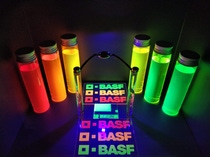BASF launches QDYESTM for sustainable wide color gamut display applications
- QDYESTM enables the production of new generation wide color gamut displays, strengthening BASF’s leading position as the partner of choice for manufacturers in need of sustainable display solutions
- QDYESTM fulfils legislative requirements for hazardous material: It is fully RoHS compliant containing no heavy metals or other hazardous compounds
- BASF’s proprietary SunvueTM color conversion technology for LED lighting, adopted in QDYESTM, also reduces harmful blue light for display applications
BASF launches QDYESTM, an organic fluorescent material for display applications, to support manufacturers in producing the next generation wide color gamut displays, serving needs in the TV/monitor, tablet, and mobile device markets.
BASF’s proprietary SunvueTM color conversion technology was launched in early 2018 to optimize blue LED light for different applications. It offers energy-efficient, bright, and comfortable lighting solutions which are close to natural sunlight. BASF’s latest QDYESTM products, organic-based fluorescent materials specially created for use in LCD backlight, are based on the ground-breaking SunvueTM color conversion technology. “SunvueTM technology represents a paradigm shift in LED lighting. It is possible to change the light of conventional LEDs and adapt it optimally for different applications. Supported by the SunvueTM technology, QDYESTM is the latest product we offer to display manufacturers in need of sustainable and wide color gamut display applications.” says Julian Proelss, Business Manager Display, BASF Electronic Materials.
Applied in color converting films via extrusion process, QDYESTM is insensitive to humidity and oxygen, and is fully RoHS compliant with no heavy metal such as cadmium and lead or other hazardous materials like indium phosphide. Due to its high efficiency and narrow emission spectra, QDYESTM achieve 100% in DCI-P3 and 80% in Rec2020 gamut when combined with suitable color filters. In addition, the organic QDYESTM can efficiently convert long wavelength LED blue light into high quality white light with less sacrifice of color gamut, the emission of harmful blue light (<455nm) is therefore drastically reduced for TUV Eyesafe® standard (https://eyesafe.com/tuv/).
To learn more about BASF’s SunvueTM color conversion technology, please visit https://www.basf.com/cn/en/media/BASF-Information/Quality-of-life/low-blue-lighting.html.
For more information about BASF’s QDYESTM products, please contact Dr. Siang Fu Hong (sean.hong@basf.com)
BASF’s Dispersions & Pigments division
The Dispersions & Pigments division of BASF develops, produces and markets a range of high-quality pigments, resins, additives and polymer dispersions worldwide. These raw materials are used in formulations for a number of industries, including coatings, construction, adhesives, printing and packaging, electronics and paper. With its comprehensive product portfolio and its extensive knowledge of the industry, the Dispersions & Pigments division offers its customers innovative and sustainable solutions and helps them advance their formulations. For further information about the Dispersions & Pigments division, please visit www.dispersions-pigments.basf.com.
About BASF
At BASF, we create chemistry for a sustainable future. We combine economic success with environmental protection and social responsibility. More than 110,000 employees in the BASF Group contribute to the success of our customers in nearly all sectors and almost every country in the world. Our portfolio is organized into six segments: Chemicals, Materials, Industrial Solutions, Surface Technologies, Nutrition & Care and Agricultural Solutions. BASF generated sales of €59 billion in 2020. BASF shares are traded on the stock exchange in Frankfurt (BAS) and as American Depositary Receipts (BASFY) in the U.S. Further information at www.basf.com.

